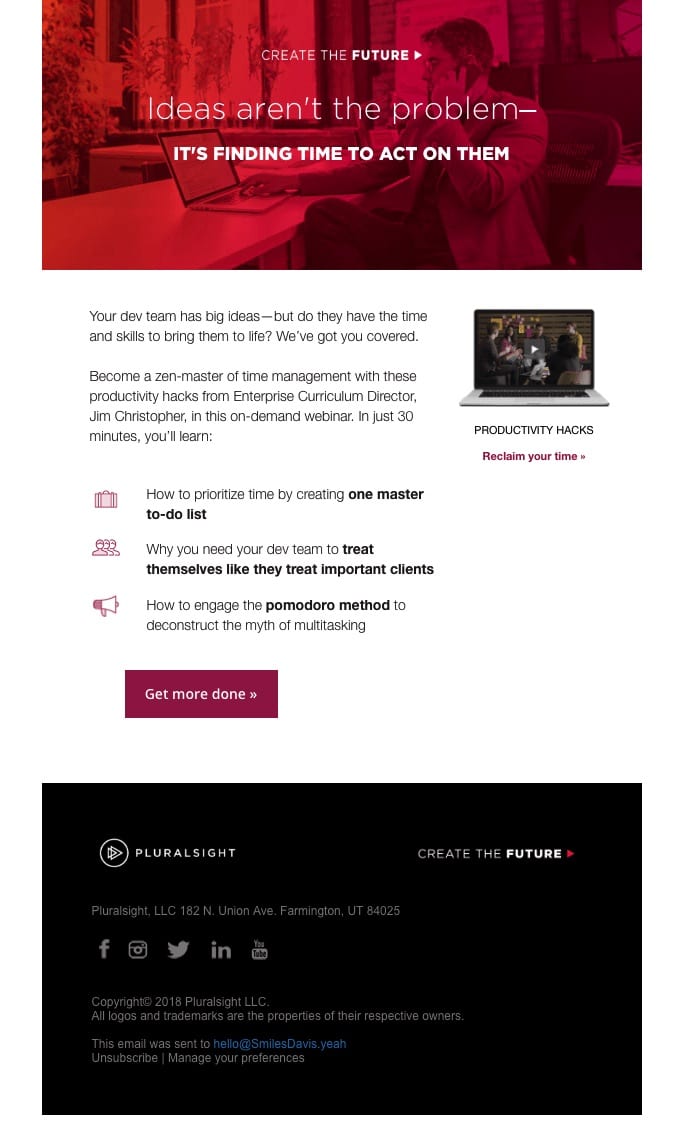Digital marketers should be constantly evaluating the performance and design of their emails. They should analyze design elements and tinker with formatting to improve readability and the user experience.
Although these are steps toward making a good email great, one important step is missing: ensuring your email copy is persuasive enough to encourage your audience to keep reading.
How do you start a persuasive email?
The most difficult part of any email is the beginning. It’s the first thing your recipient will see, so it usually plays a large role in determining whether they’ll keep reading. Your audience is quick to decide if they’re interested, so you only have seconds to hook them.
Draw them in with a clever lede.
The best way to get the attention of your readers is with a sharp header or opening statement. Whether you have a header image or not, typically every email should have a clear header that summarizes and inspires recipients to keep reading.
It’s important to note that not all emails need elaborate headers. Your template might just use your company logo. Plain-text emails won’t have a header at all, which makes the lede copy of your message that much more important.
Make the email about them, not you.
It’s easy to boast about how great your brand and products are. But at any given moment, your readers may not care. They just want to know what’s in it for them.
Pique their interest with creative storytelling about a real-world scenario or discuss some of the pain points they might be experiencing. Use the Challenger sales model as inspiration. The tactic poses a real problem that a client might face and illustrates what could go wrong in the worst-case scenario. It then leads back to the benefits of the service or brand.
Of course, in an email, you need to get to the point as soon as possible. Check out this great example from Pluralsight.
Source: Really Good Emails
This email is successful at putting the customer’s needs first by addressing an area of concern. It then ties into how Pluralsight can help with that problem, drawing readers to click on the CTA.
How to measure persuasive emails
When determining how successful your persuasive email is, you need to assume that your audience has taken the first step to open your message. You need to pay close attention to your click-through rate to measure the effectiveness of your email.
Email click-through rates average around 2.7 percent, but that can vary by industry. The more persuasive your email, the higher click-through rates you may see.
Does it really matter?
The copy in your email is the main influencer to convince your audience to take action. You need to be persuasive in your approach, focusing on your customers’ wants and needs rather than your own.
However, you still need to follow basic email marketing best practices for your persuasive email to work. If you aren’t sending to the right audience at a time that makes sense for them, your email won’t be successful. Create customer journeys to determine which point during the buyer’s journey they should receive the email. List segmentation can also ensure that your message is sent to the correct audience who’d be expecting your email.
What now?
You now know how to start a persuasive email and why it’s important for your brand. The next thing you need to do is evaluate the way your emails are currently composed. Look to see if the messaging clearly explains the benefits of your service or products to your audience. Focus on what’s in it for them and how your product or service benefits them. While you’re at it, take a look at your CTA and consider ways you can beef up your CTA copy to encourage more clicks.
